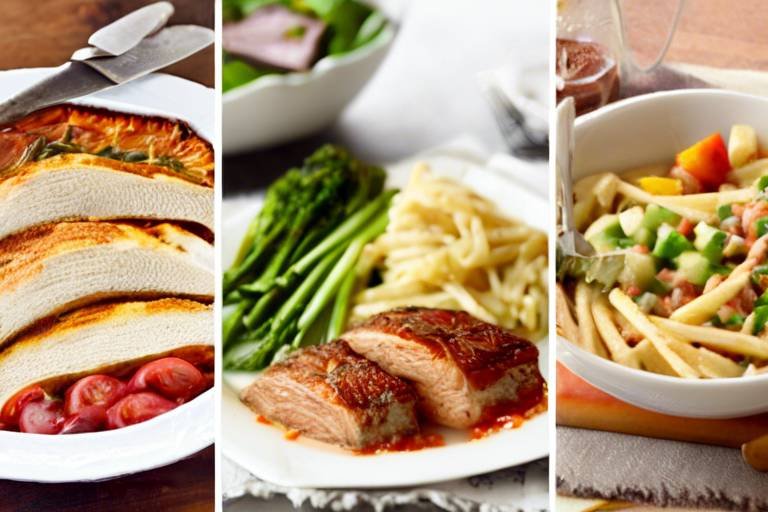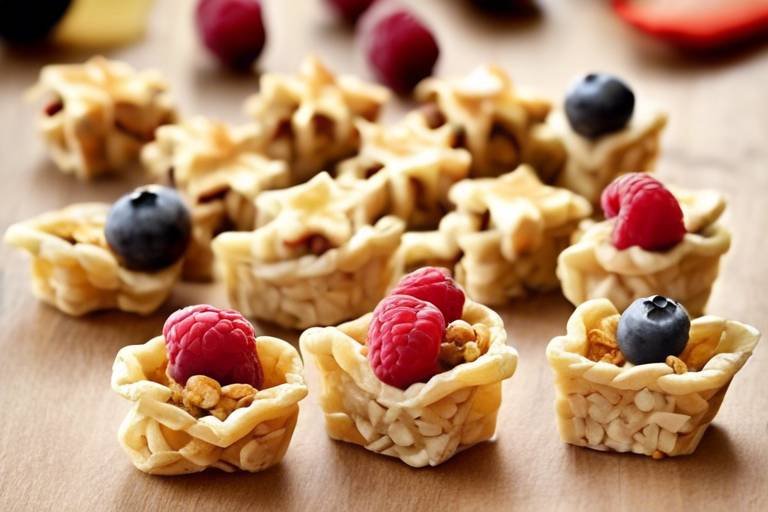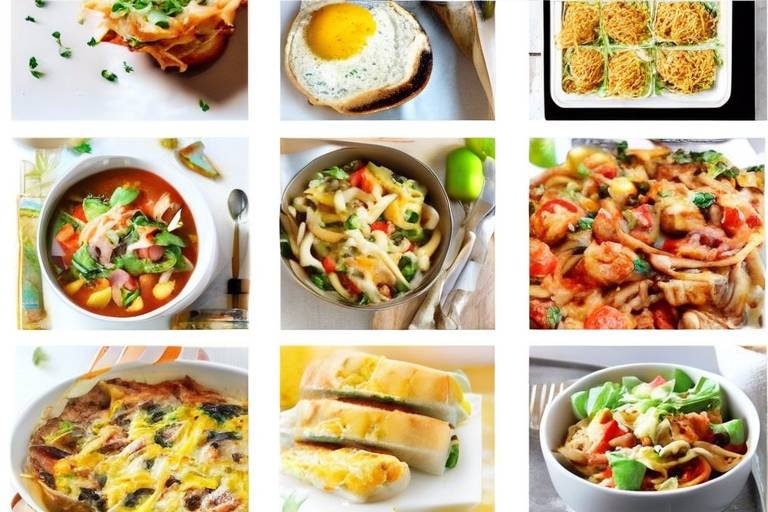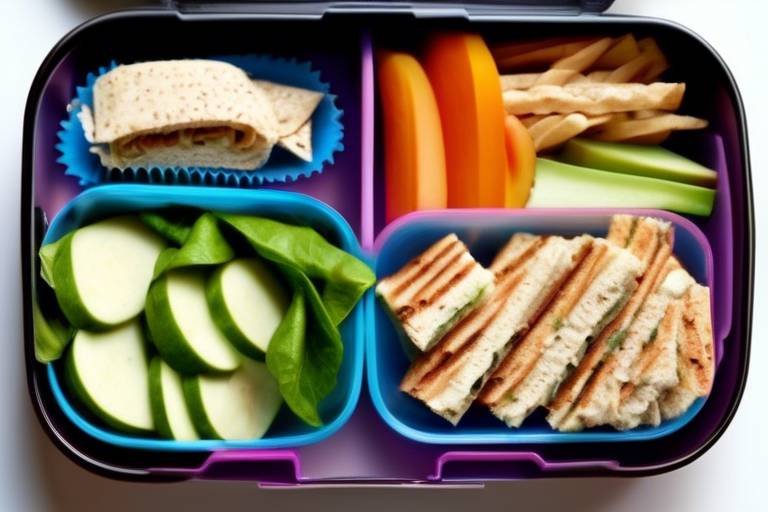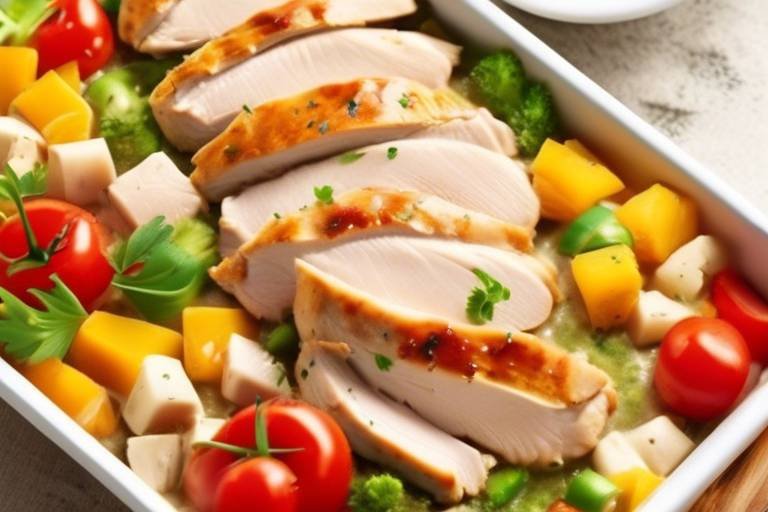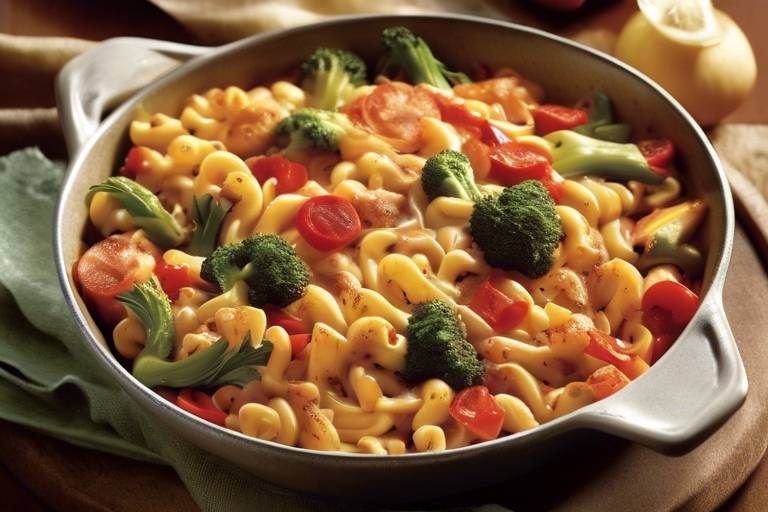Quick and Healthy Family Dinner Ideas
In today’s fast-paced world, finding the time to prepare a nutritious dinner for your family can feel like a daunting task. Between work, school, and extracurricular activities, it’s easy to resort to takeout or pre-packaged meals that lack essential nutrients. However, with a little creativity and planning, you can whip up quick and healthy family dinners that everyone will love. Imagine a weeknight where you can spend less time in the kitchen and more time enjoying the company of your loved ones. Sounds amazing, right? Let’s dive into some delicious options that will not only satisfy your family's taste buds but also keep them healthy!
Meal planning is the secret sauce to ensuring your family receives the essential nutrients they need while keeping dinner preparation quick and stress-free. Think of it as your roadmap for the week. By planning out your meals, you can ensure that each dinner is balanced, incorporating proteins, carbohydrates, and plenty of fruits and vegetables. This way, you avoid last-minute decisions that often lead to unhealthy choices. Plus, it saves you time and money! Consider using a simple template to outline your meals for the week. You could even involve your family in this process, allowing everyone to contribute their favorite dishes. Not only does this make meal planning more enjoyable, but it also ensures that everyone looks forward to dinner.
One-pot meals are a game-changer for busy families. They save time on cooking and cleaning while delivering delicious and wholesome options. Imagine throwing everything into one pot, letting it simmer, and then serving a meal that tastes like you spent hours preparing it. These meals often combine proteins, vegetables, and grains, providing a complete dish that’s both satisfying and nutritious. From hearty soups to flavorful casseroles, the options are endless! For instance, a simple chicken and vegetable stir-fry can be made in under 30 minutes, leaving you with minimal cleanup. Plus, you can get creative by using whatever ingredients you have on hand, making it a flexible option for any night of the week.
Stir-fries are not only quick to prepare but also a fantastic way to incorporate fresh vegetables and lean proteins into your family’s diet. In less than 30 minutes, you can create a colorful and nutritious dinner that everyone will enjoy. The beauty of stir-frying lies in its versatility. You can mix and match ingredients based on what’s in your fridge. For example, a combination of bell peppers, broccoli, and snap peas tossed with your choice of protein can make for a delightful meal. Not to mention, the vibrant colors of the vegetables make the dish visually appealing, especially for kids!
When it comes to stir-fries, variety is key! You can keep your meals exciting by experimenting with different vegetable combinations. Try adding seasonal vegetables like zucchini in the summer or root vegetables in the winter. Each vegetable brings its unique flavor and nutrient profile to the table. For a delightful crunch, consider adding water chestnuts or snow peas. The more colorful your stir-fry, the more nutrients you’re likely to include. So don’t be shy—mix it up and let your creativity shine!
Understanding the best protein options for stir-fries can elevate your meals while catering to different dietary preferences. You can choose from a variety of proteins such as chicken, shrimp, or tofu. Each option offers its unique taste and texture, ensuring that everyone at the table finds something they love. For instance, tofu is an excellent choice for vegetarians and can absorb the flavors of the sauce beautifully. On the other hand, chicken provides a hearty and satisfying element to the dish. Regardless of your choice, incorporating lean proteins into your stir-fries will keep your meals healthy and filling.
Sheet pan meals are another fantastic option for families looking to simplify dinner prep. The concept is simple: toss your ingredients onto a single baking sheet, season them, and let the oven do the work. This method not only results in delicious flavors that meld together but also means minimal cleanup afterward. Picture a savory salmon fillet paired with roasted asparagus and sweet potatoes, all cooked on one pan. It’s an effortless way to create a nutritious meal without spending hours in the kitchen.
To make healthy dinners even easier, consider some practical tips for preparing ingredients in advance. Meal prep might sound intimidating, but it can be as simple as chopping vegetables or marinating proteins on the weekend. This way, during the week, all you have to do is assemble and cook. Another great tip is to keep your pantry stocked with versatile ingredients like canned beans, whole grains, and frozen vegetables. These staples can be lifesavers on busy nights!
Batch cooking is a brilliant strategy that can save you time during the week. By preparing multiple meals in one go, you ensure freshness and variety without the daily hassle of cooking. For example, you could cook a big batch of quinoa and use it in salads, stir-fries, or as a side dish throughout the week. This not only reduces cooking time but also helps you avoid the temptation of unhealthy takeout options.
Lastly, let’s talk about smart freezing techniques. Freezing meals and ingredients can be a lifesaver, especially when unexpected events pop up. You can prepare larger portions of your favorite dishes and freeze them for later use. Soups, stews, and casseroles freeze particularly well. Just be sure to label your containers with dates and contents, so you can easily grab a healthy meal whenever you need it. Having these options on hand means you can always have a nutritious dinner ready, no matter how busy life gets!
- What are some quick healthy dinner ideas for kids? Try incorporating fun shapes with vegetables or using whole grain pasta with a colorful sauce.
- How can I make meal prep easier? Focus on chopping veggies and marinating proteins ahead of time. You can also batch cook grains.
- Are one-pot meals really healthy? Yes! As long as you include a balance of proteins, carbs, and plenty of vegetables, they can be very nutritious.

Balanced Meal Planning
When it comes to family dinners, is like the secret sauce that makes everything taste better. Imagine sitting down at the dinner table, surrounded by loved ones, and enjoying a meal that not only tantalizes your taste buds but also nourishes your body. It’s not just about filling up your plates; it’s about ensuring that each meal is a powerhouse of essential nutrients. But how do you achieve this without spending hours in the kitchen? Let’s dive into the art of meal planning that strikes the perfect balance between health and convenience.
First off, understanding the components of a balanced meal is crucial. A well-rounded plate typically consists of:
- Proteins: These are the building blocks of our body. Think chicken, fish, beans, or tofu.
- Carbohydrates: They provide the energy we need to keep going. Whole grains like brown rice or quinoa are fantastic choices.
- Fruits and Vegetables: A rainbow of colors not only makes your plate visually appealing but also ensures you’re getting a variety of vitamins and minerals.
- Healthy Fats: Incorporating sources like avocados, nuts, or olive oil can help with nutrient absorption and add flavor.
Now, you might be wondering, “How can I make this happen on busy weeknights?” The key is to plan ahead. Start by mapping out your meals for the week. This doesn’t have to be a daunting task; just jot down a few ideas for each night. For instance, you could designate Monday for stir-fry, Tuesday for tacos, and Wednesday for a hearty soup. This structure not only simplifies your grocery shopping but also helps you avoid the dreaded “What’s for dinner?” question that often leads to unhealthy takeout options.
Another tip is to prep your ingredients in advance. Spend a little time on the weekend chopping vegetables, marinating proteins, or even cooking grains. Having these components ready to go means you can throw together a delicious dinner in a matter of minutes. For example, if you have prepped chicken and veggies, a quick stir-fry can be on the table in less than 30 minutes!
Incorporating variety is also essential. Eating the same meals week after week can lead to boredom, which may tempt you to stray from your healthy eating goals. Try to rotate your proteins, grains, and vegetables each week. This not only keeps your meals exciting but also ensures a broader spectrum of nutrients. Think of it like a colorful palette—each ingredient adds its unique flavor and health benefits.
In summary, balanced meal planning is about making informed choices that cater to your family's health while being mindful of time constraints. By pre-planning your meals, prepping ingredients, and introducing variety, you can create a dinner routine that is both enjoyable and nourishing. So, roll up your sleeves and get ready to transform your family dinners into a delightful and healthful experience!

One-Pot Wonders
When life gets busy, the last thing you want is to spend hours in the kitchen, right? That’s where come into play! These meals are not just a lifesaver for time-strapped families but also a way to serve up delicious, nutritious dinners without the hassle of a mountain of dishes to clean afterward. Imagine the joy of cooking a wholesome meal where everything—protein, veggies, and carbs—comes together in one pot. It's like a culinary hug that warms your family from the inside out!
One-pot meals are incredibly versatile, allowing you to mix and match ingredients based on what you have on hand. Whether you’re in the mood for a hearty stew, a creamy pasta, or a vibrant stir-fry, there’s a one-pot recipe that can meet your cravings. The beauty lies in the simplicity: throw everything in, let it cook, and voilà! Dinner is served. Plus, these meals often taste even better the next day, making them perfect for leftovers.
Now, let's dive into one of the most exciting types of one-pot meals: stir-fries. These dishes are not only quick to prepare but also a fantastic way to pack in a variety of colorful vegetables and lean proteins. In less than 30 minutes, you can have a vibrant dinner on the table that’s bursting with flavor and nutrition. Think of it as a quick dance party in your kitchen where fresh ingredients twirl together in a hot pan.
When it comes to stir-fries, the options are virtually limitless! You can use a mix of your family’s favorite vegetables, ensuring each bite is a delightful surprise. Some popular choices include:
- Bell peppers
- Broccoli
- Carrots
- Snap peas
- Zucchini
These veggies not only add a pop of color but also a wealth of nutrients that contribute to a balanced diet. You can even explore seasonal vegetables to keep things fresh and exciting!
Now, let’s talk protein! The right protein can elevate your stir-fry from good to great. Whether your family prefers chicken, tofu, or shrimp, you can customize your stir-fry to cater to everyone’s tastes. Here are some options to consider:
- Chicken: A classic choice that cooks quickly and absorbs flavors beautifully.
- Tofu: Perfect for plant-based eaters, it’s a great source of protein and can be marinated for extra flavor.
- Shrimp: Cooks in a flash and adds a touch of elegance to your meal.
By mixing and matching your proteins and veggies, you can create countless combinations that will keep your family coming back for more.
Another fantastic one-pot option is the sheet pan meal. Picture this: you toss your ingredients onto a single baking sheet, pop it in the oven, and let the magic happen. Everything cooks together, allowing flavors to meld and create a symphony of taste. Plus, cleanup is as easy as tossing the foil or parchment paper in the trash! Sheet pan meals are perfect for busy weeknights when you want to serve something hearty without spending hours in the kitchen.
So, whether you’re stirring up a quick stir-fry or roasting a medley of veggies and proteins on a sheet pan, one-pot meals are a fantastic way to keep dinner stress-free and enjoyable. They’re not just meals; they’re a way to bring families together around the dinner table, sharing stories and laughter over a plate of wholesome goodness.

Stir-Fry Recipes
Stir-frying is not just a cooking technique; it's an art form that can transform your dinner table into a vibrant, colorful feast in less than 30 minutes! Imagine a sizzling pan filled with fresh vegetables and tender proteins, all coming together in a delightful medley of flavors. The beauty of stir-fry lies in its incredible versatility. You can easily tailor it to suit your family's taste preferences, dietary restrictions, and seasonal ingredients. Whether you're craving something hearty or light, there's a stir-fry recipe waiting to be discovered!
Let's break down the essentials of creating a delicious stir-fry. First, you'll want to consider your base ingredients: the vegetables. The key here is variety! You can mix and match to create a stunning array of colors and textures. For instance, you might combine crunchy bell peppers, vibrant broccoli, and sweet snap peas. Not only do these vegetables look amazing, but they also pack a nutritional punch, providing essential vitamins and minerals that your family needs. You can even experiment with seasonal produce to keep things fresh and exciting!
Next up is the protein. This is where you can really cater to everyone's preferences. Here are some popular options:
- Chicken: A classic choice, chicken breast is lean and cooks quickly.
- Tofu: Perfect for a vegetarian or vegan option, tofu absorbs flavors beautifully.
- Shrimp: A quick-cooking seafood option that adds a touch of elegance to your dish.
Once you've selected your vegetables and protein, the next step is to choose a flavorful sauce. This is where the magic happens! A simple combination of soy sauce, garlic, and ginger can elevate your stir-fry from ordinary to extraordinary. Want to add a little heat? A splash of sriracha or a sprinkle of red pepper flakes can do the trick. Don't forget to balance your flavors with a touch of sweetness, perhaps from honey or brown sugar, to create a well-rounded dish.
Now, let's talk technique! The secret to a perfect stir-fry is high heat and quick cooking. Start by heating your wok or skillet until it's smoking hot. Add a splash of oil (like sesame or vegetable oil) and toss in your protein first, allowing it to sear and develop flavor. Once it's nearly cooked through, add your vegetables, starting with the ones that take longer to cook, such as carrots or broccoli. Stir continuously to ensure everything cooks evenly and retains its crunch.
Finally, don't forget to garnish your stir-fry before serving! A sprinkle of sesame seeds or chopped green onions can add that final touch that makes your dish truly pop. Serve your stir-fry over a bed of fluffy rice or noodles for a complete meal that your family will rave about.
In summary, stir-fry recipes are a fantastic way to whip up a quick, nutritious, and delicious dinner for your family. With a little creativity and the right ingredients, you can create a dish that not only satisfies hunger but also excites the palate. So, why not give it a try? Your family will thank you for the delightful surprise!

Vegetable Variations
When it comes to creating a vibrant and nutritious stir-fry, the choice of vegetables can truly make or break the dish. Think of your stir-fry as a blank canvas, where each vegetable adds its own splash of color and flavor, transforming a simple meal into a culinary masterpiece. The best part? You can mix and match to keep things exciting and cater to your family's preferences.
Let’s dive into some popular vegetable variations that not only taste great but also pack a nutritional punch:
- Bell Peppers: These come in a rainbow of colors—red, yellow, green, and even purple! They add sweetness and crunch to your dish, along with a healthy dose of vitamin C.
- Broccoli: This cruciferous vegetable is a powerhouse of nutrients, including fiber, vitamins K and C. Plus, its unique texture holds sauces beautifully, making every bite delightful.
- Carrots: Not just for rabbits! Sliced or julienned, carrots bring a natural sweetness and vibrant color to your stir-fry, along with beta-carotene, which is great for eye health.
- Zucchini: This versatile veggie absorbs flavors well and adds a lovely softness to the mix. It’s a fantastic way to sneak in some extra veggies without overwhelming the dish.
- Snow Peas: These delicate pods are not only crunchy but also add a subtle sweetness. They cook quickly, making them perfect for fast-paced dinners.
But don't stop there! The beauty of stir-frying lies in its flexibility. You can throw in seasonal vegetables or whatever you have on hand. Think about adding mushrooms for an earthy flavor, spinach for a dose of iron, or even cauliflower for a low-carb option. The key is to keep it colorful—more colors on your plate typically mean a wider range of nutrients.
Another fun tip is to experiment with herbs and spices. Fresh herbs like basil or cilantro can elevate your stir-fry, while spices like ginger and garlic add depth and warmth. Imagine your stir-fry as a symphony, where each vegetable and spice plays its part to create a harmonious meal that your family will love.
Incorporating a variety of vegetables not only enhances the flavor but also ensures that your family is getting a well-rounded meal. So, next time you're whipping up a stir-fry, think outside the box and explore the endless possibilities of vegetable variations!
Q: Can I use frozen vegetables in my stir-fry?
A: Absolutely! Frozen vegetables are a convenient option and can be just as nutritious as fresh ones. Just make sure to add them to the pan at the right time to avoid overcooking.
Q: How do I prevent my vegetables from getting soggy?
A: To keep your veggies crisp, make sure your pan is hot before adding them. Stir-fry in batches if necessary, and avoid overcrowding the pan.
Q: What is the best way to cut vegetables for stir-frying?
A: Aim for uniform sizes to ensure even cooking. Thin slices or bite-sized pieces work best, allowing for quick cooking and easy eating.

Protein Choices
When it comes to creating a quick and healthy family dinner, the choice of protein can make all the difference. Not only does protein help in building and repairing tissues, but it also keeps everyone feeling full and satisfied. So, what are the best protein options for your stir-fries? Let's break it down!
First up, we have chicken. This versatile protein is a favorite in many households. You can slice it into thin strips and toss it into your stir-fry for a quick cook time. Not only is chicken high in protein, but it’s also low in fat, making it a heart-healthy choice. Plus, it absorbs flavors beautifully, especially when marinated in soy sauce or ginger.
If you're looking for a vegetarian option, tofu is your best friend. This plant-based protein is not only rich in protein but also packed with essential amino acids. Tofu can be cubed and sautéed until golden, adding a delightful texture to your dish. To keep things interesting, try using different types of tofu, like silken for a creamy sauce or firm for a hearty bite. For those who enjoy a little crunch, consider adding some tempeh, which has a nutty flavor and a firmer texture than tofu.
For seafood lovers, shrimp is a fantastic option. It cooks incredibly fast—often in just a few minutes—and is low in calories while being high in protein. Shrimp is also rich in omega-3 fatty acids, which are great for heart health. Just toss them in the pan with your favorite veggies and sauces, and dinner is served!
Now, let's not forget about the beef enthusiasts out there. Lean cuts of beef, like sirloin or flank steak, can be sliced thinly and stir-fried to perfection. Beef is not only a great source of protein but also provides iron and zinc, which are essential for energy and immune function. Just keep an eye on the cooking time to ensure it remains tender and juicy.
Lastly, for those who prefer a more exotic flavor, consider lamb. While it may not be the first protein that comes to mind for stir-fries, lamb can add a unique taste that your family might love. It’s packed with flavor and can be complemented with spices like cumin and coriander for an aromatic twist.
In summary, the protein choices for your stir-fry can cater to various dietary preferences and tastes. Whether you choose chicken, tofu, shrimp, beef, or even lamb, each option brings its own set of benefits. Remember, the key is to balance your protein with a colorful array of vegetables to create a meal that is not only nutritious but also visually appealing. So, next time you’re planning dinner, think about these protein options to keep your family healthy and happy!

Sheet Pan Meals
When it comes to whipping up a family dinner that is both delicious and convenient, sheet pan meals are truly a game changer! Imagine this: you come home after a long day, and instead of slaving over the stove, you can simply toss a variety of ingredients onto a single sheet pan. Not only does this method save you time during preparation, but it also cuts down on cleanup, giving you more time to spend with your loved ones.
Sheet pan meals allow you to combine proteins, vegetables, and even starches all in one place, creating a well-balanced meal that’s bursting with flavor. For example, you can pair juicy chicken thighs with vibrant bell peppers, zucchini, and sweet potatoes. Just season everything with your favorite herbs and spices, pop it in the oven, and let the magic happen!
One of the best parts about sheet pan meals is their versatility. You can easily switch up the ingredients based on what you have in your fridge or what’s in season. Here’s a quick guide to help you construct your own mouthwatering sheet pan meal:
| Protein Options | Vegetable Choices | Flavor Boosters |
|---|---|---|
| Chicken Breasts | Broccoli | Garlic Powder |
| Salmon Fillets | Asparagus | Lemon Zest |
| Tofu | Carrots | Italian Seasoning |
| Shrimp | Brussels Sprouts | Chili Flakes |
With just a few simple steps, you can create a meal that not only satisfies your family’s hunger but also delights their taste buds. Start by preheating your oven, then chop your chosen veggies and protein into bite-sized pieces. Toss them all together in a large bowl with a drizzle of olive oil and your selected flavor boosters. Spread everything out evenly on your sheet pan and let the oven do the work!
What’s more, sheet pan meals can be a fantastic way to introduce your kids to new vegetables and flavors. Since everything is roasted together, the flavors meld and create a delightful harmony that’s hard to resist. You might just find that your picky eater can’t get enough of those roasted Brussels sprouts!
And don’t forget about the leftovers! If you happen to have any, they make for a quick lunch the next day. Just pack them up in a container, and you’ll have a nutritious meal ready to go. It’s a win-win situation!
In conclusion, sheet pan meals are not just a trend; they are a practical solution for busy families looking to enjoy healthy, homemade dinners without the hassle. So why not give it a try? Your taste buds (and your schedule) will thank you!

Quick Prep Tips
In the hustle and bustle of family life, finding time to prepare healthy dinners can feel like a juggling act. But fear not! With a few , you can transform your mealtime routine into a breeze. Imagine walking into your kitchen after a long day and knowing exactly what to whip up in just a few minutes. Sounds like a dream, right? Well, it can be your reality!
One of the most effective strategies is to prepare ingredients in advance. Spend a little time on the weekends chopping vegetables, marinating proteins, or cooking grains. By doing this, you’ll have everything ready to go when the clock is ticking on a busy weeknight. For instance, if you know you’ll be making a stir-fry, pre-chop your bell peppers, broccoli, and carrots. Store them in airtight containers in the fridge, and they’ll be waiting for you when it’s time to cook.
Another great tip is to embrace batch cooking. This means preparing large portions of meals that can be easily stored and reheated throughout the week. Think of it as cooking once and eating multiple times! You can make a big pot of chili, soup, or pasta, and then divide it into individual servings. Not only does this save time, but it also ensures that you have healthy meals ready to go, which can be a lifesaver on those particularly hectic nights.
Don't forget about smart freezing techniques. Freezing is a fantastic way to preserve the freshness of ingredients and meals. You can freeze pre-cooked grains, chopped vegetables, or even entire meals. Just remember to label your containers with the date and contents to keep things organized. For example, if you make a batch of quinoa, freeze it in portions so you can easily add it to salads or stir-fries later on. This way, you’ll always have healthy options at your fingertips!
Lastly, consider creating a weekly meal plan. This not only helps you stay organized but also cuts down on the stress of deciding what to make each night. Sit down with your family and plan out the week’s dinners together. You can even involve the kids by letting them choose a dish or two. This not only makes them feel included but also encourages them to try new foods. Plus, having a plan means you can do your grocery shopping with purpose, reducing the chances of impulse buys and food waste.
Q: How can I make meal prep faster?
A: The key is to organize your kitchen and have all your tools ready. Invest in good quality knives and cutting boards, and keep your pantry stocked with essentials. This way, you can chop, cook, and store efficiently.
Q: What are some easy meals to batch cook?
A: Some great options include soups, stews, casseroles, and grain bowls. These meals can be easily reheated and often taste even better the next day!
Q: How long can I freeze meals for?
A: Most meals can be frozen for up to 3 months. Just make sure to label them with the date they were frozen to keep track of freshness.

Batch Cooking
Batch cooking is a game changer for busy families looking to maintain a healthy diet without spending hours in the kitchen every day. Imagine coming home after a long day and knowing that dinner is already prepared and waiting for you. Sounds like a dream, right? Well, with batch cooking, that dream can become a reality! This method involves preparing large quantities of food at once, which you can then portion out for the week. Not only does this save time, but it also reduces the stress of daily meal prep.
One of the best aspects of batch cooking is the variety you can incorporate into your meals. You can cook a base like quinoa or brown rice, then prepare different proteins and vegetables to mix and match throughout the week. For example, you might roast a tray of sweet potatoes, sauté some green beans, and grill chicken breasts. The next day, you can have sweet potato and chicken bowls, and the day after that, a stir-fry with green beans and rice. This way, you keep mealtime exciting without the hassle of cooking from scratch every time.
To get started with batch cooking, here are a few practical tips:
- Plan Your Menu: Choose recipes that share similar ingredients to minimize waste and maximize efficiency.
- Set Aside Time: Dedicate a few hours on the weekend or your day off to cook. You’ll be amazed at how much you can prepare in just a short time!
- Invest in Quality Containers: Use airtight containers to store your meals, keeping them fresh and ready to eat.
Additionally, consider creating a simple schedule for your batch cooking sessions. For instance, you might prepare different meals for each day of the week, ensuring that you have a variety of flavors and nutrients. Here's a sample schedule:
| Day | Meal | Ingredients |
|---|---|---|
| Monday | Chicken Stir-Fry | Chicken, bell peppers, broccoli, soy sauce |
| Tuesday | Quinoa Bowl | Quinoa, black beans, corn, avocado |
| Wednesday | Vegetable Soup | Carrots, celery, tomatoes, spinach |
| Thursday | Sheet Pan Salmon | Salmon, asparagus, sweet potatoes |
| Friday | Chili | Ground turkey, kidney beans, tomatoes, spices |
By following a batch cooking strategy, you not only save time but also ensure that your family enjoys healthy, home-cooked meals throughout the week. Plus, it allows you to experiment with different cuisines and flavors without the daily pressure of cooking. So why not give it a try? You might find that batch cooking becomes your new best friend in the kitchen!
1. How long can I store batch-cooked meals in the fridge?
Most batch-cooked meals can be safely stored in the refrigerator for about 3 to 4 days. If you want to keep them longer, consider freezing portions for later use.
2. Can I freeze all types of meals?
Not all meals freeze well, but many do! Soups, stews, casseroles, and cooked grains generally freeze nicely. Avoid freezing meals with high water content, like salads, as they may become soggy upon thawing.
3. Do I need special equipment for batch cooking?
While you don’t need anything fancy, having a good set of pots, pans, and storage containers can make the process smoother. A slow cooker or pressure cooker can also be very helpful for preparing large meals.
4. How do I reheat batch-cooked meals?
You can reheat meals in the microwave, on the stove, or in the oven. Just make sure to heat them thoroughly to an internal temperature of 165°F (74°C) for safety.

Smart Freezing Techniques
When it comes to juggling a busy family life, can be a game-changer. Imagine opening your freezer to find a treasure trove of healthy, home-cooked meals ready to go! Not only does freezing help preserve the freshness of your ingredients, but it also allows you to whip up nutritious dinners in a flash. The key is knowing how to freeze food properly to maintain flavor and texture.
First off, let's talk about prepping your meals before freezing. This means cooking in batches or preparing ingredients that can be easily assembled later. For example, you can cook a large pot of chili or soup and divide it into individual portions. These can be stored in freezer-safe containers, making it easy to grab a meal on hectic days. Remember, the best way to keep things organized is to label each container with the date and contents. This way, you won't end up with a mystery meal that you forgot about!
Next, consider the type of containers you use for freezing. Glass containers are excellent for freezing because they are durable and help prevent freezer burn. However, if you prefer plastic, make sure it’s labeled as freezer-safe. Vacuum-sealing is another fantastic option, as it removes air and extends the life of your food significantly. Plus, it saves space! When you vacuum-seal meals, you can stack them neatly in your freezer, turning it into a well-organized meal prep hub.
Another technique to consider is freezing individual portions. This is especially useful for meals like casseroles or baked goods. Simply scoop out single servings into muffin tins or ice cube trays, freeze them until solid, and then transfer them to a larger container. This way, you can easily pop out a portion whenever you need it. It’s like having a personal chef at your fingertips!
Don’t forget about freezing fruits and vegetables. If you have extra produce that’s about to go bad, chop it up and freeze it for later use in smoothies or stir-fries. Just wash and dry them, spread them out on a baking sheet to freeze individually, and once frozen, transfer them to a freezer bag. This method helps maintain their texture and flavor, allowing you to enjoy the taste of summer even in the dead of winter.
Finally, let’s address the thawing process. The way you thaw your food can make a big difference in the final dish. The best method is to transfer frozen meals to the refrigerator the night before you plan to eat them. This slow thawing process helps maintain the quality of the food. If you’re short on time, you can use the microwave, but be cautious as it can sometimes cook the edges while leaving the center frozen.
To sum it up, mastering smart freezing techniques can transform your dinner game. With a little planning and organization, you can ensure that healthy meals are always just a few minutes away. So, next time you cook, think about how you can freeze your extras and create a culinary safety net for those busy weeknights!
- Can I freeze any type of food? - Most foods can be frozen, but some items like lettuce and certain dairy products may not freeze well.
- How long can I keep food in the freezer? - Generally, food can be stored in the freezer for 3 to 6 months, but this can vary based on the type of food.
- Is it safe to refreeze food? - It’s safe to refreeze food that has been thawed in the refrigerator, but avoid refreezing food that was thawed at room temperature.
Frequently Asked Questions
- What are some quick dinner ideas for busy families?
Some quick dinner ideas include one-pot meals like stir-fries, sheet pan dinners, and simple pasta dishes. These meals can be prepared in 30 minutes or less, making them perfect for hectic weeknights.
- How can I ensure my family is eating balanced meals?
To ensure balanced meals, focus on including a variety of food groups: lean proteins, whole grains, healthy fats, and plenty of fruits and vegetables. Meal planning can help you keep track of nutrients and create well-rounded dinners.
- What are one-pot meals, and why are they beneficial?
One-pot meals are dishes that can be cooked in a single pot or pan, which saves time on cooking and cleaning. They are beneficial because they allow for easy preparation and often result in rich, blended flavors.
- Can you suggest some quick stir-fry recipes?
Absolutely! Try a chicken and broccoli stir-fry with soy sauce, or a tofu and bell pepper mix with garlic and ginger. Both can be ready in under 30 minutes and are packed with nutrients!
- What are some effective prep tips for busy weeknights?
Some effective prep tips include chopping vegetables in advance, marinating proteins ahead of time, and cooking grains like rice or quinoa in bulk. This way, you can quickly assemble meals when it's time to eat.
- How does batch cooking save time during the week?
Batch cooking allows you to prepare multiple meals at once, which means you can enjoy homemade dinners without having to cook from scratch every night. Just reheat and serve!
- What are smart freezing techniques for preserving meals?
Smart freezing techniques include portioning out meals in airtight containers, using freezer bags to save space, and labeling items with dates. This makes it easy to grab healthy options whenever you need them!

